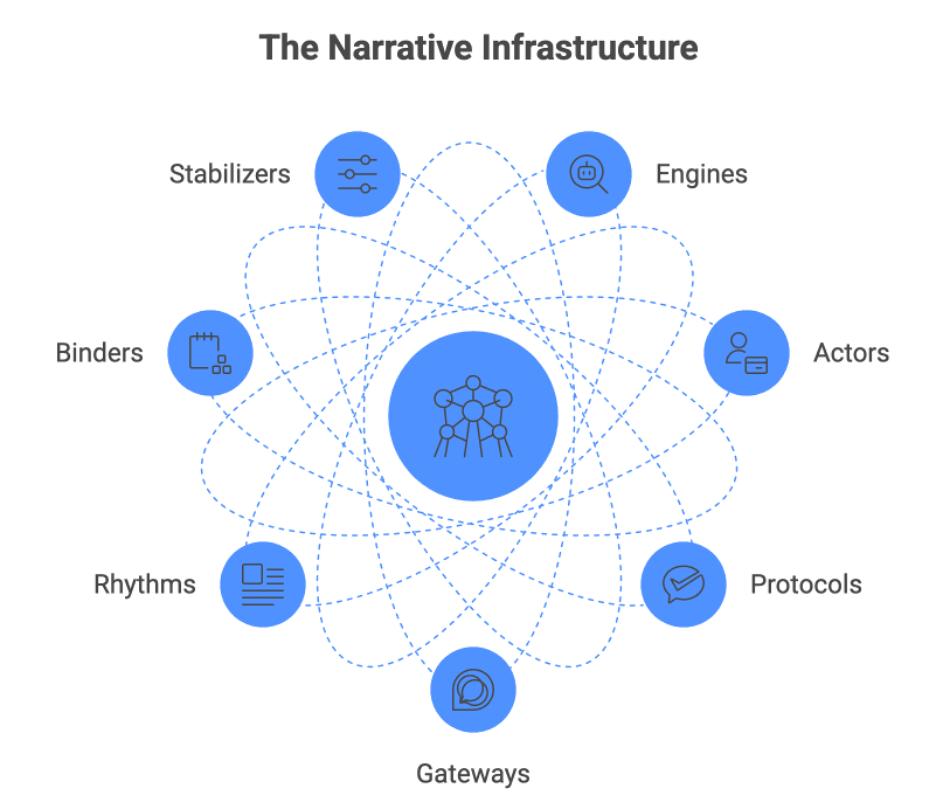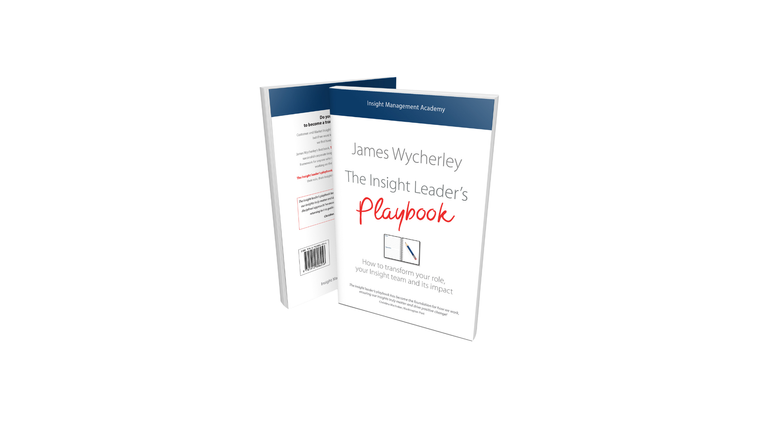Narrative Infrastructure, Not Facts
Your crisis communications strategy is broken because you are fighting the wrong battle. While you craft careful statements and wait for legal approval, algorithms are already deciding which version of your story reaches millions of people.

Your crisis communications strategy is broken because you are fighting the wrong battle. While you craft careful statements and wait for legal approval, algorithms are already deciding which version of your story reaches millions of people. Search, social feeds, and AI chatbots promote whatever gets the most clicks and shares, not what is most accurate. A misleading TikTok video can reach a large audience in the time it takes your team to schedule a meeting. By the time your fact-check goes live, public opinion has hardened around the wrong narrative. You need real-time measurement tools and immediate response protocols to win the speed game that now determines corporate reputation.
The Infrastructure Problem
Managers are losing control of their brand narratives. The cause is not simply misinformation, but the automated infrastructure of platform AI. Ranking engines, recommendations, autocomplete, and AI assistants decide what stakeholders see first, how quickly stories accelerate, and which frames stick. The old playbook of silence and after-the-fact debunks no longer works. Leaders must shape credibility signals early and mobilize allies before the narrative hardens.
We break the narrative system, map the five-stage story arc, provide desk-ready measurement tools, and deliver a 72-hour intervention playbook.
The Narrative Infrastructure
Any narrative system has seven moving parts that determine which stories win.

Engines filter and rank information through search algorithms, recommendation feeds, and AI assistants. They steer attention toward engaging content, not factual content. You compete on engagement signals. Not mere facts alone.
Actors include people, institutions, and automated accounts that post and amplify content. Platforms reward speed and engagement over accuracy, so fast, provocative claims prevail over slow, careful truths.
Protocols are the formal and informal platform rules, content formats, community guidelines, and API limits that shape what gets said and when it gets seen. These need to be mastered to improve timing and reach.
Gateways are entry points to public attention, like trending topics, news carousels, and top search results. The brand narrative must pass through these checkpoints to reach scale.
Rhythms dictate the speed and flow of information through posting cycles and news cycles. During a crisis, narratives accelerate at a highly rapid pace, rendering sporadic communication ineffective.
Binders are recurring tags, phrases, visuals, and templates that tie posts into coherent narratives. Without consistent binders, your messaging appears fragmented.
Stabilizers anchor public trust through official websites, named expert spokespeople, and clear disclosures. These are the foundations of your credibility in an AI-mediated environment.
The Five-Stage Story Arc
Every narrative follows this pattern.

Ignition: A trigger appears. A post spikes, an image circulates, or a problematic AI answer gets shared. These first hours frame the entire issue. Hesitation hands control to others.
Acceleration: Platform engines amplify the initial narrative based on engagement, causing velocity to compound. Pre-planned communication cadence is crucial here. Sporadic updates get outpaced.
Reframing: The first intervention opportunity. Shift the narrative lens with new facts, better visuals, or authentic human voices. Deploy stabilizers to re-anchor the story in credible ground.
Saturation: Peak public attention where simple repetition yields diminishing returns. Adding noise is counterproductive. Pivot from broadcasting to consolidating around a single authoritative hub.
Settlement: Dominant public understanding solidifies. This outcome reflects all previous stages. Successful use of stabilizers and binders settles the narrative closer to facts. Failure creates expensive correction campaigns.
Four Levers That Control Outcomes
Pacing Lever: Beat Platform Velocity
Controls: Rhythms, Gateways
Platform algorithms are speed demons. They amplify whatever moves fastest during peak attention windows. If you wait for legal approval or perfect information, you lose. A telecom company facing service outages posted updates every two hours during prime social media time slots, even when they had no new technical details. This prevented conspiracy theories from filling the information vacuum and kept their narrative in trending topics.
Measure posting-pace skew: Calculate your peak-hour versus off-hour posting ratio. If 80% of the conversation happens in 10% of the time, you are in crisis velocity mode. Adjust your rhythm or get buried.
Messaging Lever: Preserve Authenticity
Controls: Binders, Actors
AI writing tools sand down rough edges until everything sounds like corporate communications manual text. This backfires spectacularly. Audiences smell artificial polish from miles away.
A CEO wrote a frank apology about a product recall, mentioning specific engineering failures. The AI assistant rewrote it into bloodless corporate speak. The original version tested 3x better with customers who appreciated direct accountability and human voice.
Measure template density: Count cookie-cutter phrases per 100 words. High density signals authenticity death spiral. Pull back from AI assistance and let real voices through.
Localization Lever: Demonstrate Ground Truth
Controls: Protocols, Binders
Generic global messaging is the kiss of death when communities face specific problems. Algorithms boost content showing actual local awareness because it drives higher engagement from affected audiences.
A food manufacturer addressing contamination rumors in three states included specific facility locations, local health department contacts, and regional distribution timelines. Generic corporate statements from competitors got buried while this response dominated search results and trending feeds.
Track local reference rate: Count concrete places, names, policies per 100 words. Low rates predict expensive reframing battles when your message feels disconnected from ground reality.
Human Handover Lever: Provide Expert Access
Controls: Stabilizers, Protocols
When automated systems hit their limits, people need obvious escape routes to human expertise. No exceptions. The cost of routing complex cases to humans is always less than trust damage from bot loops.
A hospital system's symptom checker included direct links to nurse hotlines and urgent care booking for any concerning responses. Patient satisfaction scores jumped 40% compared to systems offering only automated follow-up questions.
Monitor handover rate: Track the percentage of high-stakes responses offering clear human expert access. Low rates indicate dangerous over-reliance on automation.
Three Failure Scenes
The Over-Polished Executive Post: An executive drafts a direct note on a pricing error, but an AI assistant smooths the hard accountability into polished, generic language. This creates a weak binder that fails to signal authentic leadership. The high template density gets read by staff as inaction, and the narrative settles on cynicism, eroding internal trust.
The Tone-Deaf Crisis Reply: A food brand answers a local rumor with a generic, globally-approved statement. The low local reference rate is immediately obvious to the community, making the brand seem out of touch. This failure to use appropriate binders allows the rumor to gain a second life, forcing a costly reframing effort to rebuild trust.
The Unhelpful AI Advisor: A city chatbot answers public health questions with polite, automated text. While efficient, its low handover rate offers no clear path to human experts, which is a critical failure. This lack of a key stabilizer makes residents feel unheard and ultimately erodes trust in the system, causing them to flood phone lines anyway.
10-Rule Playbook for the First 72 Hours
Disclose AI Assistance: Be transparent about machine-assisted public replies. This acts as a foundational stabilizer and builds long-term trust.
Replace Stock Empathy with Action: Limit generic AI-generated empathy in customer service. High template density instantly feels impersonal. Pair empathetic words with concrete resources or actions.
Create Clear Human Handovers: When stakes are high, make the path to human experts as obvious as possible. This directly improves your handover rate and serves as your most powerful stabilizer.
Add Local Reference Early: Include one concrete local detail in your first reply to improve the local reference rate. This simple action can prevent costly reframing cycles later.
Set Pace to Control Acceleration: Break high posting-pace skew with timed, substantive updates. A steady rhythm during the acceleration stage beats many small, reactive responses.
Audit AI-Driven Templates: Avoid tools that automatically scrub authentic language from leadership posts. This prevents high template density and preserves binder credibility.
Publish a Frame Ledger: Create a single, authoritative hub pairing each claim with your counter-evidence. This is the key reframing stage tactic and serves as a powerful stabilizer.
Deploy Human Stabilizers: Put credible experts on record. Authoritative human voices are the strongest stabilizers, and their credibility always beats anonymous volume.
Govern Your Internal AI: Define clear guardrails and assign human oversight for your AI tools. This allows you to manage your own engines and protocols effectively.
Measure and Adapt Strategy: Actively track the four key indicators. If the saturation stage arrives and engagement halves, use data to pivot from broadcasting to direct service and remediation.
Your 72-Hour Implementation
Hours 1-24: Establish Control (Ignition/Acceleration Stage)
Deploy human experts immediately, who possess specific local knowledge. Create a single authoritative information hub. Set posting rhythm to match conversation velocity, not internal approval cycles. Speed trumps perfection at this stage.
Hours 25-48: Hold Position (Reframing Stage)
Audit AI responses for issues with generic language. Replace "we understand your concerns" with concrete actions and resources. Maintain a steady update rhythm even when information is scarce. Silence gets filled by others.
Hours 49-72: Consolidate Victory (Saturation/Settlement Stage)
Shift from broadcasting to consolidation as peak attention hits. Direct all communications toward your hub. Prepare handoff protocols as public attention naturally cycles to the next crisis.
Implementation Requirements
Build desk-level tracking for the four lever metrics. Establish pre-cleared expert contacts with bypassed approval chains. Establish AI governance rules to prevent the automated sanitization of leadership communications. Train your team to recognize velocity shifts and pivot tactics accordingly.
The 30-Second Brief for Leadership
Our core challenge has shifted from correcting false content to actively managing the narrative infrastructure that shapes stakeholder belief. We are transitioning from a reactive to a proactive approach. Our team now uses four key metrics to diagnose narrative risk in real-time and a 72-hour playbook to act decisively. This approach protects brand reputation, reduces crisis cycle costs, and maintains stakeholder trust in our AI-driven media environment.


